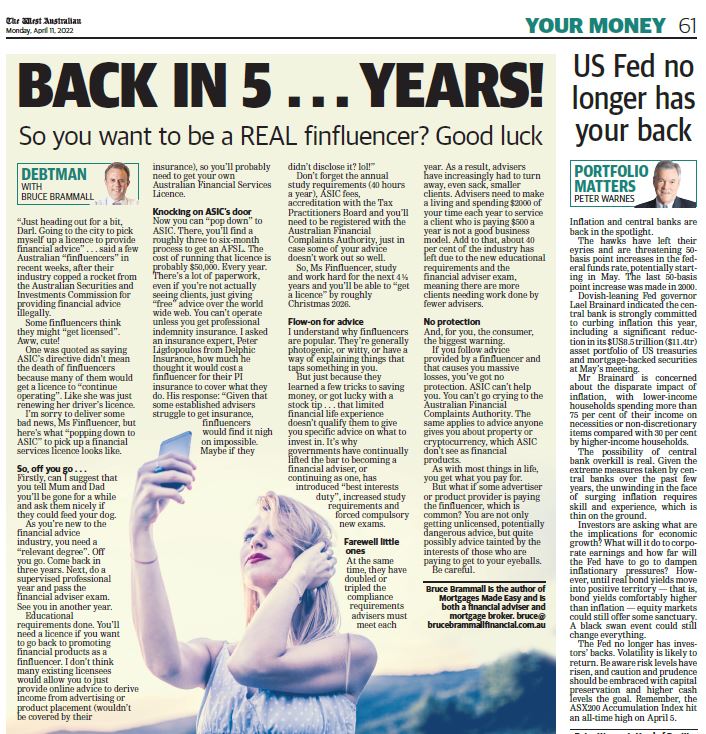Bruce Brammall, The West Australian, 11 April, 2022
“Just heading out for a bit, Darl. Going to the city to pick myself up a licence to provide financial advice.”
… Said a few Australian “finfluencers” in recent weeks, after their industry copped a rocket from ASIC for providing financial advice illegally.
Some finfluencers think they might “get licensed”. Aaww, cuuuute!
One was quoted saying ASIC’s directive didn’t mean the death of finfluencers, because many of them would get a licence to “continue operating”.
Like she was renewing her driver’s licence at the transport department.
I’m sorry to deliver some bad news, Ms Finfluencer, but here’s what “popping down to ASIC” to pick up a financial services licence looks like.
“Back in five … years”
Firstly, can I suggest that you tell mum and dad you’ll be gone for a while and ask them nicely if they could feed your dog.
As you’re new to the financial advice industry, you need a “relevant degree”. Off you go. Come back in three years.
Next, to do a supervised professional year and pass the financial adviser exam. See you in another year.
Educational requirements done. You’ll need a licence if you want to go back to promoting financial products as a finfluencer. I don’t think many existing licensees would allow you to just provide online advice to derive income from advertising or product placement (wouldn’t be covered by their insurance), so you’ll probably need to get your own Australian Financial Services License.
Knocking on ASIC’s door
Now you can “pop down” to ASIC. There, you’ll find a roughly three- to six-month process to get an AFSL.
The cost of running that licence is probably $50,000. Every year. There’s a lot of paperwork, even if you’re not actually seeing clients, just giving “free” advice over the world wide web.
You can’t operate unless you get professional indemnity insurance. I asked an insurance expert, Peter Ligdopoulos from Delphic Insurance, how much he thought it would cost a finfluencer for their PI insurance, to cover what they do.
Peter’s response: “Given that some established advisers struggle to get insurance, finfluencers would find it nigh on impossible. Maybe if they didn’t disclose it? lol!”
Don’t forget the annual study requirements (40 hours a year), ASIC fees, accreditation with the Tax Practitioner’s Board and you’ll need to be registered with the Australian Financial Complaints Authority (in case some of your financial advice doesn’t work out so well).
So, Ms Finfluencer, study and work hard for the next 4.5 years and you’ll be able to “get a licence” by roughly Christmas 2026.
Flow-on for advice
I understand why finfluencers are popular. They’re generally photogenic, or witty, or have a way of explaining things that taps something in you.
But just because a finfluencer learned a few tricks to saving money, or got lucky with a stock tip … that limited financial life experience doesn’t qualify them to give you specific advice on what to invest in.
It’s why governments have continually lifted the bar to becoming a financial adviser, or continuing as one, has introduced “best interests duty”, increased annual study requirements, forced compulsory new exams.
Farewell little ones
At the same time, they have doubled or tripled the compliance requirements advisers must meet each year.
As a result, advisers have increasingly had to turn away, even sack, smaller clients. Advisers need to make a living and spending $2000 of your time each year to service a client who is paying $500 a year is not a good business model.
Add to that, about 40 per cent of the industry has left due to the new educational requirements and the financial adviser exam, meaning there are more clients needing work done by fewer advisers.
No protection
And, for you, the consumer, the biggest warning.
If you follow advice provided by a finfluencer and that causes you massive losses, you’ve got no protection. ASIC can’t help you. You can’t go crying to AFCA.
(The same actually applies to advice anyone gives you about property or cryptocurrency, which ASIC doesn’t see as financial products.)
As with most things in life, you get what you pay for.
But what if some advertiser or product provider is paying the finfluencer, which is common? You are not only getting unlicenced, potentially dangerous, advice, but quite possibly advice tainted by the interests of those who are paying to get to your eyeballs.
Be careful.
Bruce Brammall is the author of Mortgages Made Easy and is both a financial adviser and mortgage broker. E: bruce@brucebrammallfinancial.com.au.

